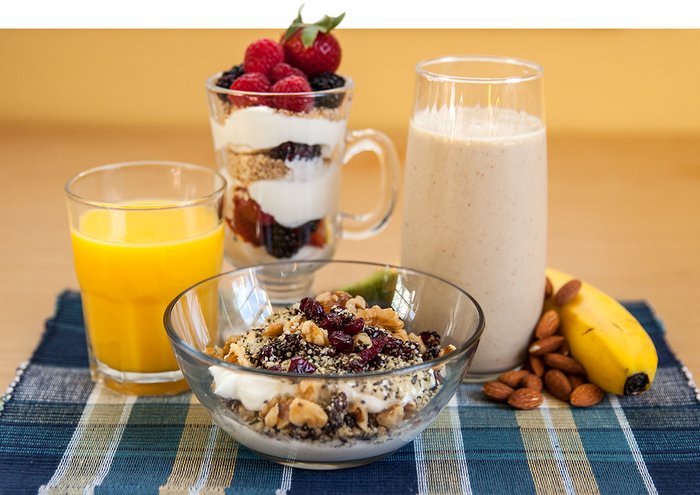Getting ready to embark on your very own transformation? Between setting up a nutrition program and choosing which workout program best meets your goals, it can seem like an overwhelming process. The specific path you choose can have a big impact on the degree of your success, but what's the best way to get started?
Whether your goal is to carve chiseled abs or bulk into a hulking titan, it's easier to learn from the pros than to go it alone. Whatever your goal, other people have come before you, and they can serve as your guides. Follow these simple tips from the elite fitness athletes of Team EAS so you can crush your goals!
1. Keep Your “Why” Front And Center
When asked for his best transformation tip, super-fit athlete and coach Jason Wittrock doesn't dive into complicated nutrition tips or detailed training splits. Instead, he hammers home the importance of "mind before muscle."
"In order to transform yourself and create lasting change, you must have a strong enough why," Wittrock says. "The road to success is littered with adversity and obstacles, and reminding yourself of your why in these moments will help you overcome them."
Don't know your why? We bet you do. Jason suggests asking yourself some tough questions about why you really want to change your body. Is it for yourself, a loved one, or your kids? How would it hurt to fail? What would that physical success bring to your life—longevity, the ability to do the activities you want, more confidence, or something else entirely?
You need answers to these questions, and you need to be able to see them. Put a reminder on your phone's lock screen. Post it on your fridge. Tattoo it on your arm (OK, not really). Do what it takes to make it part of your day, so you don't have to search for answers when you need them.
2. Embrace Planning As A Lifestyle
Let's face it: some of us are better at planning than others. That's not going to change. But if you want to incorporate healthy eating and fitness into a life that currently doesn't have them, you'll need to be organized about it.
The difference between a healthy diet and an out of control one is preparation. "Have clean, healthy food ready to go at all times," says IFBB bikini pro Annie Parker. "Likewise, plan your workouts by scheduling them on your calendar, just like you would schedule a meeting."

"Have clean, healthy food ready to go at all times," says IFBB bikini pro Annie Parker. "Likewise, plan your workouts by scheduling them on your calendar, just like you would schedule a meeting."
It would be great if everything went according to plan, but life rarely works that way. This is why Parker and Wittrock swear by "back-pocket workouts" that can be pulled out whenever necessary, such as when it feels like your schedule won't allow what your program demands. They detailed four such routines, all minimal on equipment and high on intensity, in their article "Transformed in 20: 4 Quick and Effective Workouts." Consider keeping a list of your favorite such routines in your gym bag so you're never at a loss!
Parker also recommends that you plan your supplementation routine just as seriously, using a pill box so you know exactly what you have and have not taken every day. She also recommends leaving your protein and other essential daily supplements somewhere you can see them at all times, like on your kitchen counter, rather than buried in a cupboard.
3. Amplify Your Workouts
Once you start strength training regularly, it can be tempting to get caught up in how much weight you're pushing (or pulling). There's a downside to this approach, though. The more weight you move, the fewer reps you can do, and the fewer calories you'll likely burn.
If transformation is your goal, embrace it by keeping most of your workouts fast-paced and intense. A library's worth of books have been written about how to do this, so even if you like your current program, look for ways to amp it up.
Two of the best techniques are:
- Supersets: Alternating two exercises for contrasting body parts without rest
- Cardio acceleration: Alternating strength movements with faster, lighter movements like jumping rope or bodyweight squats

"I incorporate a 'shocker set' at the end of each exercise to completely exhaust the target muscle and cause maximum damage to the muscle tissue," [Wittrock] says. "I push past failure using forced reps, negative reps, rest-pause reps, and dropsets."
Likewise, you could hit all your reps in your normal routine, but on the final set, go for broke. That's how Wittrock trains. "I incorporate a 'shocker set' at the end of each exercise to completely exhaust the target muscle and cause maximum damage to the muscle tissue," he says. "I push past failure using forced reps, negative reps, rest-pause reps, and dropsets."
His favorites are all worth having in your toolbox. Don't use them all at once or every set, but if you feel like you still have more in the tank, they'll help you turn it into results!
- Forced reps: Your training partner slightly helps you get a couple more reps after you've hit failure
- Negative reps: You continue doing reps of the lowering part of a movement after hitting failure, with your partner helping you raise the weight back up
- Rest-pause: You rest for a few seconds after hitting failure, get one more rep, then do it again
- Dropsets: You strip some weight off after hitting failure at a certain weight, and keep going until you hit failure again
4. Make A Playlist Of Transformation Meals
What keeps people from transforming? One obstacle is definitely the fear of eating the same foods each and every day for 12 weeks or more. You're not a competitive bodybuilder, so why would you eat like one? Instead, create a roster of 5-10 easy, nutrient-rich recipes you can lean on during your transformation.
These "hits" don't have to be every meal, but they should definitely make up the bulk of whatever daily meal gives you the most trouble. Which one is it for you? Is breakfast a panicked free-for-all, or is lunch the caloric sinkhole?
When you have your answer, attack that meal with all your new passion for planning. Break it down to protein, carbs, and fats, and plan it out for the next two weeks. Make it into a strength— the healthiest meal of your day! Our visual macro guides can help.
- Measuring Your Macros: What 30 Grams Of Protein Looks Like: Want to build muscle and lose fat? Then you need protein! Here's how much you need and how to measure it for each meal.
- Measuring Your Macros: What 50 Grams Of Carbs Looks Like: Carbs are your body's favorite energy source. Learn which carb sources are best and how you can easily measure them without using a scale!
- Measuring Your Macros: What 20 Grams Of Fat Looks Like: Contrary to popular belief, fat is not the enemy! Learn how to easily add a serving of healthy fats to your diet.
5. Track Everything That Matters
Writing down what you just lifted or ate may seem meaningless at first. After all, why bother noting something you already know? But the thousands of people who have succeeded with EAS's legendary Body for Life Challenge over the last 20 years swear that this step makes all the difference.
Why? In a word, awareness. When you know what you ate, you have a baseline from which you can make incremental changes. On the other hand, not knowing how much you're lifting or the amount of protein you're eating will make it difficult to know where you're doing things right or wrong.

When it comes to measuring progress, tracking sets the record straight.
When it comes to measuring progress, tracking sets the record straight. There's something very powerful in realizing that you've added 20 pounds to your squats since starting your program or shaved off two inches from your waist. Without tracking, you're simply in the dark.
6. Don't Trust The Scale To Tell The Whole Story
"I feel different and my clothes fit differently, but the scale hasn't changed!" How many times have we heard these words? Too many to count.
It's easy to get hung up on the number that greets you every time you hop on the bathroom scale, but that measurement is just one of many. And often, it's the last one to show progress that's definitely happening!
"When it comes to seeing change, remember to give yourself time and realize that, if you're burning fat and building muscle, stalled weight doesn't mean your body composition isn't changing," say Wittrock.

"When it comes to seeing change, remember to give yourself time and realize that, if you're burning fat and building muscle, stalled weight doesn't mean your body composition isn't changing," say Wittrock.
For a better way to gauge your progress try any of these:
- How your clothes fit
- How your lifts have progressed
- How you feel during the day
- Body fat or lean muscle
- The amount of time it takes you to finish a workout
- The amount of time it takes you to recover between workouts
- Your enthusiasm for training
We could keep going. The important part is that you do, too!
7. Supplement Smart And Simple
You can find someone who swears by just about any supplement out there. But the truth is that you can achieve some pretty incredible things while using only the basics: protein, a pre-workout, and BCAAs.
The quality and intensity of your training matters a lot—more than most people realize—and a pre-workout and BCAAs can help boost both. Protein powder can help you make sure your nutrition is up to the task of turning that training into results.
Plus, as Wittrock attests, a little flavor could be just the thing you need to finally start drinking as much water as you know you're supposed to.
"I hate drinking plain water, and I'm constantly craving sugary drinks that I know are bad for me and cause weight gain," say Wittrock. "I simply add my blue raspberry or lemonade BCAAs to my jug of water and drink it throughout the day. I'm able to kill two birds with one stone by making sure my body gets a steady supply of aminos for recovery and ample water to keep my system functioning at 100 percent."
8. Schedule Time For Recovery
Recovery is probably the most overlooked part of training. Get enough of it, and you'll feel great and be able to maintain intensity across workouts. Don't get enough, and you'll begin to resent your training in days—and give up in just a couple of weeks.
If you're trying to make an immense change in a short time—and make no mistake, the 12-week schedule popularized by the Body For Life challenge is a short time—you need to take recovery as seriously as you take training.
"My goal when I leave the gym is to immediately start the recovery process by resting and feeding my body proper nutrients," says Wittrock. "If I don't allow the muscle to rest and recover, then it never has a chance to adapt and build stronger muscle fibers."
Explore different types of recovery-boosting techniques. There's no shortage of them! Foam rolling, stretching, self-massage, hot and cold hydrotherapy, meditation, active recovery, and yoga can all help, often for little or no money out of pocket. Sleep deeply, take care of yourself, and give yourself an edge in the upcoming week of workouts.
Don't just trust that your body will heal. Give it help, and then push it to the limit again!

